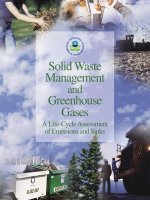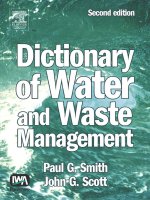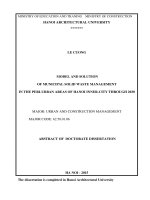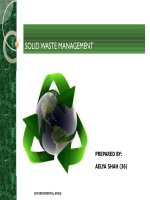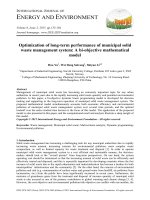Hybrid modelling of integrated solid waste management systems
Bạn đang xem bản rút gọn của tài liệu. Xem và tải ngay bản đầy đủ của tài liệu tại đây (3.98 MB, 152 trang )
HYBRID MODELLING OF INTEGRATED SOLID
WASTE MANAGEMENT SYSTEMS
KANG YONG CHUEN
NATIONAL UNIVERSITY OF SINGAPORE
2012
HYBRID MODELLLING OF INTEGRATED SOLID
WASTE MANAGEMENT SYSTEMS
KANG YONG CHUEN
(B.Eng.(Hons.), NUS)
A THESIS SUBMITTED
FOR THE DEGREE OF MASTER OF ENGINEERING
DEPARTMENT OF INDUSTRIAL AND SYSTEMS
ENGINEERING
NATIONAL UNIVERSITY OF SINGAPORE
2012
Executive Summary
For policymakers in the area of integrated solid waste management (ISWM)
planning, it is important and extremely helpful to have a decision support tool that
helps to understand the processes and factors guiding system behaviour and
observed phenomena. This model should include social behaviour model
explaining individual’s motivation in environmental behaviour but also macro
processes such as that of waste flow and processing systems as well as measure
the overall environmental impact. Consequently, such a model can help to identify
effective leverage points and provide a platform to discuss policies taking into
account environmental, economic, and social aspects. This thesis develops a
hybrid modelling approach built upon classical system dynamics methodology to
derive a simulation model that can be used as such a decision support tool. The
methodology is applied to model a case study, ISWM Singapore and scenarios
were built to simulate key outcomes and strategies.
i
ACKNOWLEDGEMENTS
I would like to thank the following people for making the thesis possible:
Assistant Professor Ng Tsan Sheng, my supervisor, for his support, guidance and
patience throughout the course of this research.
And everyone who has helped in one way or another.
ii
CONTENTS
Executive Summary
i
ACKNOWLEDGMENTS
ii
LIST OF FIGURES
v
CHAPTER 1 Introduction
1
1.1 Background
1
1.2 Problem Statement
3
1.3 Objectives
5
1.4 Research Methodology
6
1.5 Organization of Thesis
8
CHAPTER 2 System Dynamics of ISWM: Singapore
10
2.1 Background of ISWM Singapore
10
2.2 Waste Treatment Technologies
14
2.3 Dynamic Hypothesis of ISWM Singapore
16
CHAPTER 3 Literature Review
24
3.1 Modelling of Solid Waste Management
24
3.2 Comparison of Approaches
30
3.3 Conclusion
31
CHAPTER 4 Enriching System Dynamics Simulation
32
4.1 Reinterpreting Classical SD as AB Concepts
33
4.2 Integrating FIS as Behaviour Approximation
45
iii
4.3 Conclusion
52
CHAPTER 5 Modelling ISWM Singapore
55
5.1 Waste Generation Subsystem
53
5.2 Waste Separation Behaviour Subsystem
55
5.3 Waste Flow Systems
68
5.4 Waste Processing Systems
70
5.5 Emissions Model
74
5.6 Model Validation
76
5.7 Conclusion
8l
CHAPTER 6 Scenario Building and Results
76
6.1 Business As Usual
84
6.2 Population Scenarios 1-3
93
6.3 Scenario 4: Raising Awareness Efforts
102
6.4 Scenario 5: Improved Recycling Facilities
109
6.5 Scenario 6: Increase Awareness And Facilities
Adjustment
112
6.6 Scenario 7: Garbage Bag Charge
115
6.7 Scenario 8: Garbage Bag Charge, Increase Awareness
and Facilities Adjustment
123
6.8 Summary of Results
127
CHAPTER 7 Conclusion
129
7.1 Summary
129
7.2 Contributions
130
7.3 Suggestions for Future Research
131
iv
REFERENCES
133
Appendix A
137
v
List of Figures
Figure 1.1 ISWM as a Socio-Technical System
2
Figure 1.2 Enriched System Dynamics Modelling
6
Figure 2.1 Overview of ISWM Singapore
17
Figure 2.2 Causal Loop Diagram for ISWM Singapore
18
Figure 2.3 Causal Loop Diagram for Waste Separation Behaviour
20
Figure 2.4: Causal Loop Diagram for Waste Generation Behaviour
22
Figure 4.1 System Dynamics Bass Diffusion Model
33
Figure 4.2 Results from SD Bass Diffusion Model
35
Figure 4.3 State Chart of a Consumer Agent
35
Figure 4.4 Arrayed Stock
36
Figure 4.5 The Advert Effect Transition
37
Figure 4.6 Word of mouth structure with IThink commands
38
Figure 4.7 Results from AB Bass Diffusion Model
39
Figure 4.8 AB Bass Diffusion Model with Accumulation of Advert
Influence
42
Figure 4.9 Enriched AB Bass Diffusion Model
44
vi
Figure 4.10 Results of Enriched AB Bass Diffusion Model
45
Figure 4.11 FIS Flow Chart
46
Figure 4.12 FIS in system dynamics
48
Figure 4.13: System Dynamics Model of Customer Tipping FIS
50
Figure 4.14: System Dynamics Model of Restaurant Performance
with embedded FIS
51
Figure 5.1 Waste Generation Subsystem
53
Figure 5.2 Population of Singapore (Thousands)
54
Figure 5.3 Food Waste Generation Per Capita (kg per month)
54
Figure 5.4 Packaging Waste Generation Per Capita (kg per month)
55
Figure 5.5: Conceptualization of an Agent in Waste Separation
Behavior Subsystem
58
Figure 5.6: Perceived Monetary Incentives
61
Figure 5.7: Actual Awareness
63
Figure 5.8: Effort Levels for Landed and Apartment
64
Figure 5.9: Fuzzy Inference Systems Calculators
66
Figure 5.10 Food Waste Flow System
69
Figure 5.11 Packaging Waste Flow System
70
vii
Figure 5.12 Incineration Subsystem
70
Figure 5.13 Anaerobic Digesting and Aerobic Composting (AD and
AC) Subsystem
72
Figure 5.14 Landfill Subsystem
73
Figure 5.15 Emissions Accounting
75
Figure 5.16 Emissions Sub Model
77
Figure 5.17 Actual Vs Simulated Food Waste Recycling Rate
78
Figure 5.18 Proportion Commercial under Agreement Input Data
79
Figure 5.19 Actual Vs Simulated Packaging Waste Recycling Rate
79
Figure 5.20 Actual Vs Simulated Landfilling (Million Tons)
80
Figure 5.21 Actual Vs Simulated Incinerating (Million Tons)
80
Figure 6.1 Projected Food Waste Recycling Rates
85
Figure 6.2 Projected Packaging Waste Recycling Rates
85
Figure 6.3 BAU Domestic Food Recycling Rates
86
Figure 6.4 Assumed growth of commercial agreement with food
waste processing plants
86
Figure 6.5: BAU Domestic Packaging Waste Recycling Rate
87
Figure 6.6 BAU Packaging Waste Recycling Effort Levels
88
viii
Figure 6.7 BAU Net Global Warming Potential (Million Tons of
CO2-eq)
89
Figure 6.8 BAU Waste treatment by processing method (Million
Tons)
90
Figure 6.9 BAU Proportion of Electricity Needs
91
Figure 6.10 Population Scenarios (‘000s)
92
Figure 6.11 Waste Loads for Incineration (million tons)
93
Figure 6.12 Waste Loads for Packaging Recycling (million tons)
94
Figure 6.13 Waste Loads for Anaerobic Digestion (million tons)
95
Figure 6.14 Waste Loads for Aerobic Composting(million tons)
96
Figure 6.15 Waste Loads for Landfills(million tons)
97
Figure 6.16 Global Warming Potential in CO2-eq (million tons)
98
Figure 6.17 Number of Landfill Years Left
100
Figure 6.18 Electricity output as a proportion of total electricity
needs
101
Figure 6.19: Increase in Awareness Efforts for Food Waste
Recycling
102
Figure 6.20: Increase in Awareness Efforts for Packaging Waste
Recycling
102
Figure 6.21: Food Waste Recycling Rates under Increased
Awareness
103
Figure 6.22: Packaging Waste Recycling Rates under Increased
Awareness
103
ix
Figure 6.23: Net Global Warming Potential (Million Tons of CO2eq) under Increased Awareness
104
Figure 6.24 : Landfilling years left under Increased Awareness
105
Figure 6.25: Electricity Output as a percentage of Consumption
under Increased Awareness
106
Figure 6.26: Incineration and Packaging Waste Recycling Volumes
(mil tons) under Increased Awareness
108
Figure 6.27: AD and AC Volumes (mil tons) under Increased
Awareness
108
Figure 6.28: Increase in Recycling Facilities for Food Waste
Recycling
109
Figure 6.29: Increase in Recycling Facilities for Packaging Waste
Recycling
110
Figure 6.30: Food Waste Recycling Rates under Increased Facilities
110
Figure 6.31: Packaging Waste Recycling Rates under Increased
Facilities
111
Figure 6.32: Food Recycling Rates under A+F
112
Figure 6.33: Packaging Recycling Rates under A+F
112
Figure 6.34: Global Warming Potential under A+F
113
Figure 6.35: Landfill Years Left under A+F
113
Figure 6.36: Electricity Output as a % of needs under A+F
114
Figure 6.37: Waste loads for Incineration and Packaging Recycling
under A+F
114
Figure 6.38: Waste loads for AC and AD under A+F
115
x
Figure 6.39: Garbage Bag Charge Schedule
117
Figure 6.40: Food Waste Recycling Rates under GBC
118
Figure 6.41: Packaging Waste Recycling Rates under GBC
118
Figure 6.42: Global Warming Potential (mil tons CO2-eq) under
GBC
120
Figure 6.43: Landfill Years Left under GBC
120
Figure 6.44: Electricity Output as a percentage of need under GBC
121
Figure 6.45: Incineration and Packaging Recycling Loads (mil tons)
under GBC
121
Figure 6.46: AD and AC Recycling Loads (mil tons) under GBC
122
Figure 6.47: Food Waste Recycling Rates Comparisons
124
Figure 6.48: Packaging Waste Recycling Rates Comparison
124
Figure 6.49: Global Warming Potential Comparison
125
Figure 6.50: Landfill Years Left Comparison
126
Figure 6.51: Incineration Loads Comparison
126
xi
List of Tables
Table 2.1 Waste Composition and Recycling Rates Singapore 2010
14
Table 3.1 Comparison of Approaches
30
Table 4.1 Example 2D Array of agent influences in the WOM
effect
43
Table 4.2: Rule Base for Customer Tipping
49
Table 5.1: Distribution of Agents
62
Table 5.2: Awareness and Effort Levels on Basic Commitment
67
Table 5.3: Perceived Monetary Incentive and Current Commitment
Level on Commitment from Incentives
Table 5.4: Difference with Average Commitment and Current
Commitment Level on Commitment from Social Alignment
Table 5.5: Overcrowding Index and Awareness Level on Purity of
Waste Recycled
67
67
67
Table 5.6 Monthly other waste streams to landfill (tons)
74
Table 5.7 Emissions (kg per kg)
75
Table 5.8 CO2 Equivalence
75
Table 5.9 CO2 Avoidance (kg per kg)
75
Table 6.1 Simulation Scenarios
84
xii
Chapter 1: Introduction
1.1 Background
Confronted with global climate changes and a rapid expansion in population,
modern cities of today have the challenge of tackling ever increasing loads of
solid waste in an environmentally sustainable way. Waste when not handled
appropriately is not simply an unpalatable sight, but can also pose serious health
hazards. This is especially so in cities where waste output is high and people live
in close proximity. Solid waste management is thus a critical issue that requires
policy makers to take a long term systems view in order to come up with effective
solutions. Landfills and incineration methods are currently the two most popular
methods that mega cities adopt to handle large volumes of waste. However,
relying on these methods is insufficient in the long run to cope with ever
increasing material consumption and rapidly expanding populations. Landfills
will start filling up and the need for ever increasing capacity for incineration is not
just costly in monetary terms but also in the increasing severity of the emission of
greenhouse gases. The incorporation of alternative technologies in waste
management such as composting and anaerobic digesting should be used to
mitigate the amount of emissions by the solid waste management system.
A successful Integrated Solid Waste Management System (ISWM), which is
defined as a comprehensive waste prevention, recycling, composting and disposal
program. [US Environment Protection Agency, 2002], not only encompasses the
above technical challenges, but also understanding and modifying social behavior
regarding waste. The aggregated behavior of every individual thus forms the basis
1
of a sustainable waste management of a city. These behaviors affect critical
components such as waste generation (consumption habits) to waste disposal.
Personal as well as situational factors have been identified by researchers to
explain the motivation behind these behaviors. A good understanding of these
factors will thus enable to drive social behavior to a more environmentally
sustainable one.
Waste
• Sources
•Quantities
•Composition
Options
• New Tech
•New Systems
Objectives
• Costs
•Environment
Source Separation and Collection
Energy
Landfilling
Recycling Stations
Transfer Stations
Transport
Central Separation
Bio-Treatment
Fuel Production
Landfilling
Incineration
Materials
Energy
Emissions
Figure 1.1 ISWM as a Socio-Technical System
In light of the two main challenges identified, namely, technical and sociocultural, policy makers of city planning today are therefore in charge of planning
not just the infrastructural foundation of solid waste management but also the
social behaviors that underlies waste generation and disposal habits. The problem
2
at hand can therefore be formulated as a large-scale socio-technical systems
engineering problem.
Figure 1.1 illustrates the integrative conceptualization that captures the
aforementioned fact that waste management is not simply technical management
but as well as social behavior management, especially in the area of waste
generation and waste separation, which lies right at the top of this socio-technical
system.
1.2 Problem Statement
The scale and complexity of an ISWM call for a systems engineering approach
[Soderman, 2003]. This will enable the delivery of well-considered policies that
puts waste management on the track of sustainable development.
Underscoring large scale systems engineering is systems thinking, the process of
understanding how things influence each other within a whole. It is a framework
for seeing interrelationships rather than individual parts and for seeing patterns of
change rather than static snapshots or events [Senge, 1990]. Systems thinking
facilitates the understanding of large scale complex systems. System Dynamics is
one tool to apply systems thinking.
The System Dynamics Society defines System Dynamics as a methodology for
studying and managing complex feedback systems, such as those in business,
economy and other social systems [Forrester, 1961]. System dynamics models are
not immune from forecast inaccuracies and potential misuses in decisions.
However, the main utility of such models is not precision forecasting, but for
understanding and learning system structure and policy design. According to
3
Sterman [2000], the purpose of modelling is to eliminate problems by changing
the underlying structure of the system. The development of causal and simulation
models can be done through systems thinking [Senge, 1990; Anderson et al.,
1997] and system dynamics methodology [Forrester, 1961; Sterman 2000].
System Dynamics by itself however is unable to capture adequately all the critical
components of a large scale socio-technical system. Some of these components
are:
1. Capturing aggregate social behaviour such as that of recycling behaviour
2. Emissions accounting which provide us with a metric system on the
environmental front to compare planning scenarios.
Agent based modelling offers a superior capability of modelling aggregate social
behaviour due to its “bottom-up” approach as compared to the “top-down”
approach of system dynamics. A primary reason is that the system dynamics
framework drives users to make models at the macro structure level, which is not
particularly suited for modelling aggregate social behaviour. In contrast, agent
based modelling paradigm does not assume macro-structure, but simulates and
observes and emergent aggregate behaviour from micro-decision of semiautonomous individual agents. These agents have heterogeneous preferences and
goals as well as relationships amongst themselves, thus offering a more complete
picture of the emergent macro behaviour that we seek [Pourdehnad et al, 2002]
In the aspect of emissions accounting , Life-Cycle Assessment provides a wellestablished framework for calculating the global warming potential of waste
treatment processes. [Khoo et al, 2010]
4
An integration of such methodologies would thus be ideal to capture all the salient
features of an ISWM. However more often than not, the modeller needs to resort
to combining multiple simulation platforms for the different methodologies. This
has proved to steepen the learning curve for any modeller as it is often technically
difficult to pass information around software platforms and allow concurrent
simulation.
With the above issues in mind, this thesis thus seeks to construct a simulation
model to aid in the planning of ISWMs through a hybrid modelling approach,
whilst keeping the modelling effort confined to a single software platform.
1.3 Objectives
For policymakers in the area of ISWM planning, it is important and extremely
helpful to have a decision support tool that helps to understand the processes and
factors guiding system behaviour and observed phenomena. This model should
include
social
behaviour
model
explaining
individual’s
motivation
in
environmental behaviour and also macro processes such as that of waste flow and
processing systems. A measure of the overall environmental impact should also be
encompassed. Consequently, such a model can help to identify effective leverage
points and provide a platform to discuss policies that takes into account
environmental, economic, and social aspects.
In summary, this thesis seeks to construct an ISWM decision support tool in the
form of a system dynamics model in a hybrid modelling approach.
5
1.4 Research Methodology
A literature review was conducted to determine the present situation in modeling
of ISWM’s and the various insights derived to solve the problems concerned with
waste management. Research on methodologies such as system dynamics, agent
based modeling; fuzzy expert systems and life cycle assessment is also reviewed.
A simulation model is then developed using an enriched system dynamics
methodology to simulate the environmental impacts of policy options on several
aspects of ISWM, namely:
1. Reducing waste generation rates
2. Encouraging recycling/waste separation behavior
3. Allocation of waste to the different waste processing technologies
The enriched systems methodology is achieved through a hybrid modeling
approach as depicted in Figure 1.2.
System Dynamics Model
Agent Based
Modeling
Fuzzy Expert
System
Life Cycle
Assessment
Figure 1.2 Enriched Systems Dynamics Modelling
6
Here, we present some definitions of the methodologies incorporated into the
system dynamics framework.
Agent Based Models
Agent-based models (ABM) are computational models in which a large numbers
of interacting agents (individuals, households, firms, and regulators, for example)
are endowed with behavioral rules that map environmental cues onto actions.
Such models are capable of generating complex dynamics even with simple
behavioral rules because the interaction structure can give rise to emergent
properties that could not possibly be deduced by examining the rules themselves.
Fuzzy Inference System
Fuzzy inference systems (FIS) are one of the most famous applications of fuzzy
logic and fuzzy sets theory. They can be helpful to achieve classification tasks,
offline process simulation and diagnosis, online decision support tools and
process control. The strength of FIS relies on their ability to handle linguistic
concepts. These FIS contain fuzzy rules built from expert knowledge and they are
called fuzzy expert systems or fuzzy controllers, depending on their final use.
Prior to FIS, expert knowledge was already used to build expert systems for
simulation purposes. These expert systems were based on classical boolean logic
and were not well suited to managing the progressiveness in the underlying
process phenomena. Fuzzy logic allows gradual rules to be introduced into expert
knowledge based simulators. It also points out the limitations of human
knowledge, particularly the difficulties in formalizing interactions in complex
7
processes. This kind of FIS offers a high semantic level and a good generalization
capability.
Life-Cycle Assessment
A life cycle assessment (LCA) is a framework to assess environmental impacts
associated with all stages of a production or processing method. In recent years,
LCA is seen as an emerging tool to measure and compare the environmental
impacts of human activities as it allows the identification and quantification of the
potential environmental impacts of different technologies [Khoo et al, 2009]. The
high-level steps of an LCA involve constructing a Life Cycle Inventory followed
by a selection of impact categories. Scenarios are then constructed and normalized
to allow for comparison.
1.5 Organization of Thesis
The thesis consists of seven chapters. The outline of the chapters is as follows:
Chapter 1 serves as an introductory text to the research project. The background
related to the research study is first described. Next, the related problem being
studied is stated. The objectives of the research project are then articulated. Lastly,
the organization of the thesis is outlined to inform the reader of the topics covered
in the following chapters.
In Chapter 2, a specific case scenario of an ISWM (Singapore) is described,
providing technical and socioeconomic details of the system we are going to
model. Following which, a dynamic hypothesis is proposed through the use of
causal loop diagramming.
8
In Chapter 3, a literature review of past related research works on the modeling of
ISWM’s and its related impacts are conducted. A wide variety of methodologies
are explored. Lastly, some hybrid modeling approaches are reviewed.
Chapter 4 presents the modeling methodology developed in this research.
Example problems are used to illustrate the modeling process. The end of the
chapter elaborates on how these methodologies can be applied and integrated to
modeling ISWMs.
Chapter 5 deals with the building of a prototype model using a system dynamics
approach. A simulation model based on the context described in Chapter 2 is built
using the hybrid methodologies laid out in Chapter 3. Some reference modes are
chosen and validated against simulation results at the end of the chapter.
In Chapter 6, the dynamic hypothesis is validated by the comparison of the results
generated by the prototype model and historical data. After this, future planning
scenarios are built and analysis and discussion are carried out. Policy insights are
also examined.
Chapter 7 presents a conclusion to the research project. A summary of the
research objectives (Section 1.3), the activities carried out and the results obtained
are provided. The limitations faced by the study are discussed. Then, contributions
made by the research project are noted. Lastly, further research work pertaining to
the research project is suggested.
9
Chapter 2: System Dynamics of ISWM: A
Case of Singapore
In this chapter, we shall describe a specific case scenario of an Integrated Solid
Waste Management system of Singapore. From this, we then form a dynamic
hypothesis about the ISWM. These will then allow us to derive a simulation
model that will enable us to achieve the research objectives set out (Section 1.3).
2.1 Background of ISWM Singapore
The small island city state of Singapore is located at the southern tip of the
Malayan peninsula. The main island, together with 57 small islands within the
sovereignty, measures 137 kilometres north of the equator. The current population
is 5.183 million people [Singstats, 2011]. With just 682 square kilometers of land
and thus one of the highest population density per square kilometer, Singapore has
a severe land scarcity problem.
Before 1979, solid waste in Singapore was disposed of by landfill dumping.
However, as development accelerated and intensified the land shortage problem,
the authorities resorted to incineration methods. Although incineration as a waste
disposal method costs 6 – 7 times more than simply landfilling, the process
reduces the volume of waste by 90% and weight by 80%. This is thus a preferred
method for Singapore, who cannot spare more land for open dumping. [Foo,
1997]. To date, Singapore has 4 incinerator plants at Ulu Pandan, Tuas, Senoko,
and Tuas South to handle the solid waste generated [National Environment
Agency, 2011].
10
Despite such radical improvements, the amount of solid waste generation in
Singapore has been steadily increasing with increasing affluence and changing
lifestyles. From 1,260 tons in 1970 to 7,600 tons in 2000, this is a six-fold
increase in three decades of the solid waste disposed in Singapore. The total
amount of waste collected in the year 2001 was 2.8 million tons with domestic
refuse accounting for 49% of the refuse originated and non-domestic refuse from
industrial premises and institutions accounting for the other 51%. This statistic
translates into 0.93 kilograms of domestic waste generated per Singaporean per
day. [National Environment Agency, 2011] The incinerator plants at Ulu Pandan,
Tuas, and Senoko are reaching their designed capacities. Singapore opened a new
landfill, Semakau Landfill, in 1999 at an estimated construction cost of S$1.2
billion [Foo, 1997]. If the amount of solid waste in Singapore is allowed to grow
in the trend projected from the current amount of solid waste generated, it is
estimated that Singapore will need a new incineration plant every five-seven years
and a new landfill site every thirty years [Ministry of Environment, 2001]. This is
expensive and unsustainable for several reasons:
1. Extremely high costs of construction and maintenance of new incinerator
plants (Estimated costs of S$1.2 Billion per new plant [Foo, 1997] ) which
will have to be borne by public finances.
2. Highly pollutive nature of incinerators, releasing large amounts of toxins
and greenhouse gases [ GAIA, 2003 ] ( Detailed emissions levels provided
in Table 5.7 )
In 1991, the Ministry of Environment of Singapore set up a Waste Minimisation
Unit to spearhead waste minimisation and recycling in Singapore. By February
11



